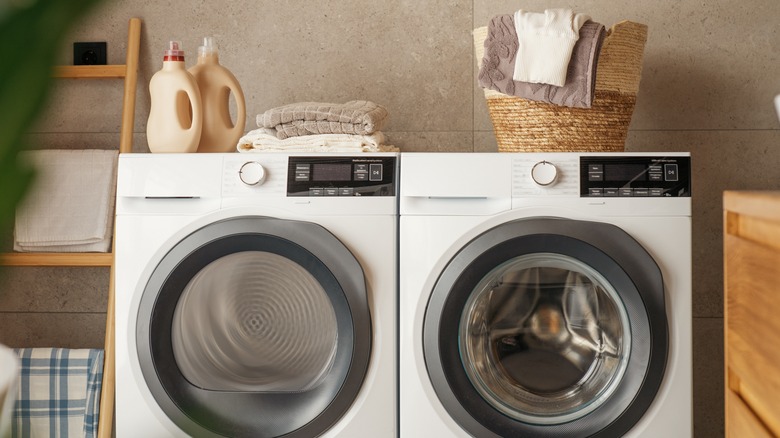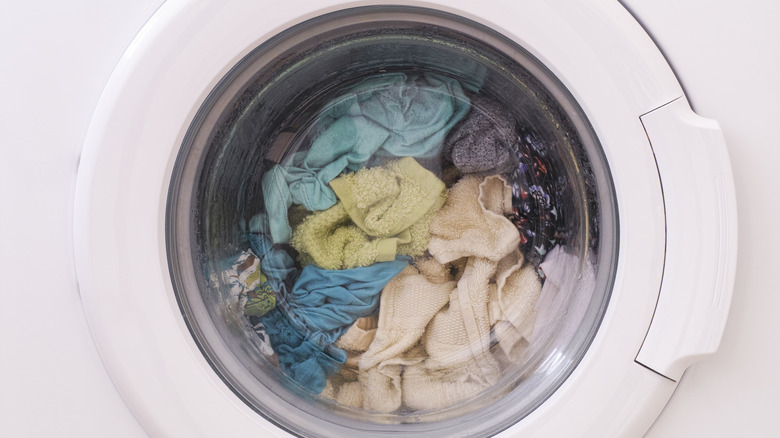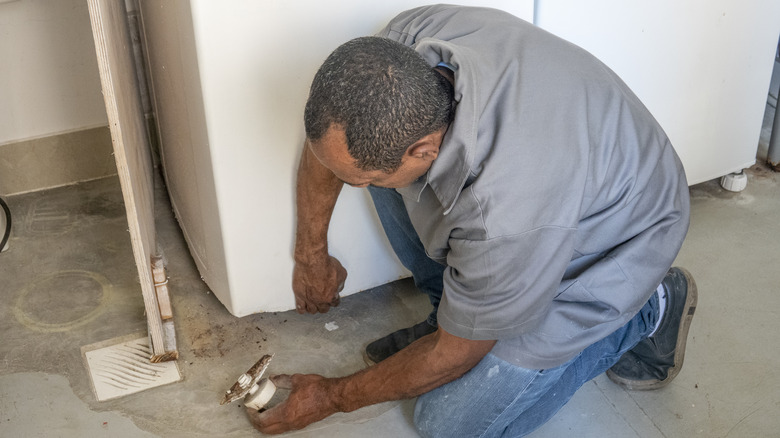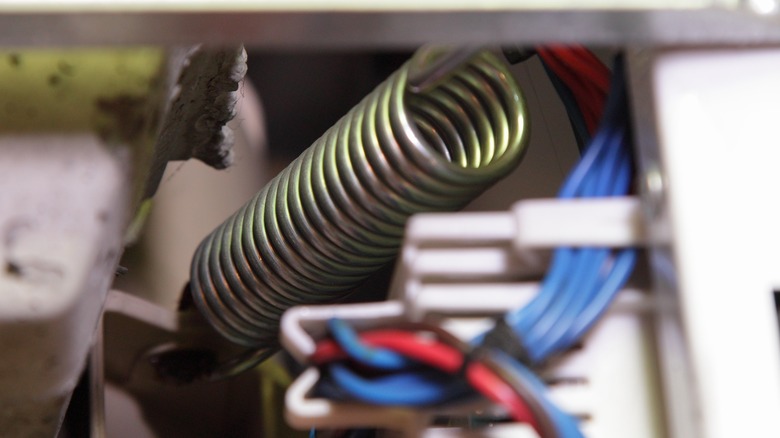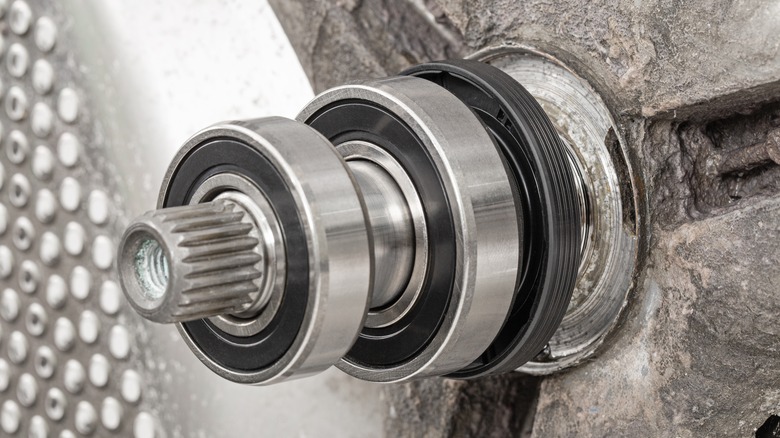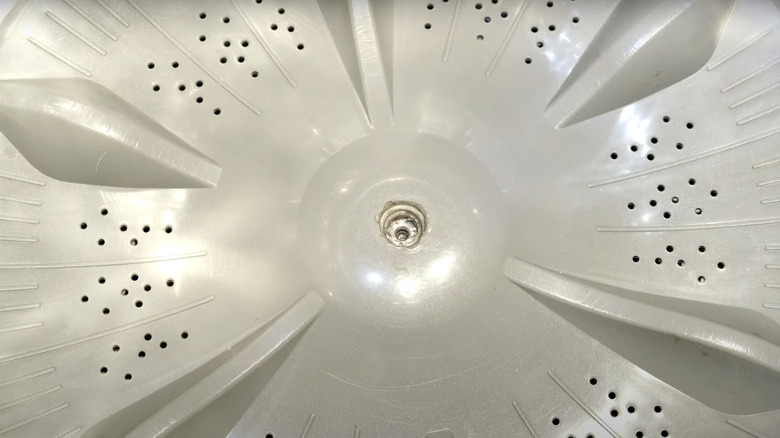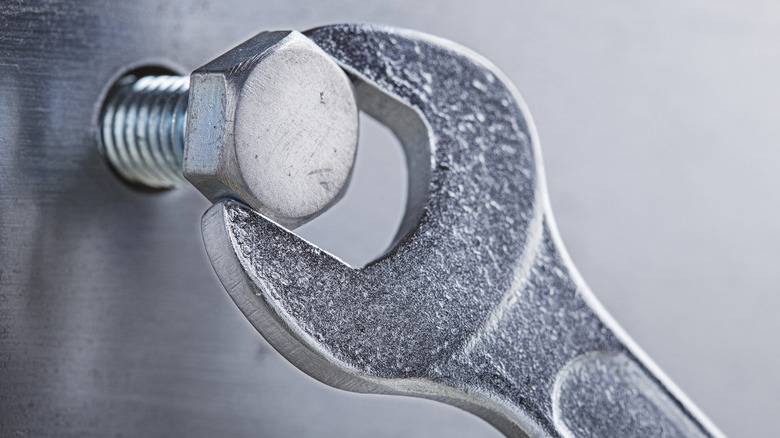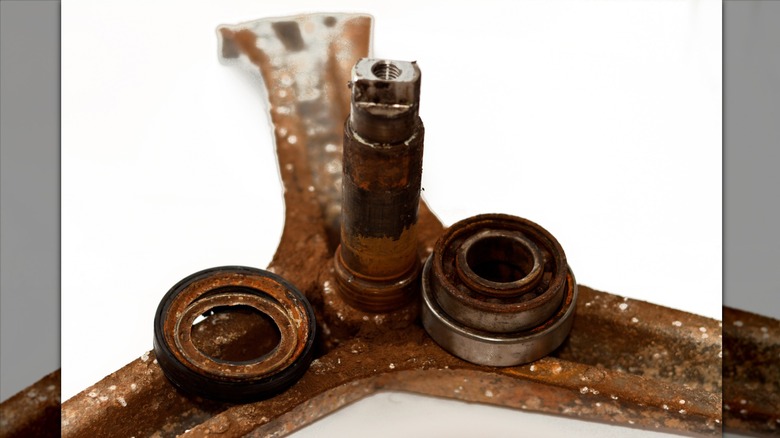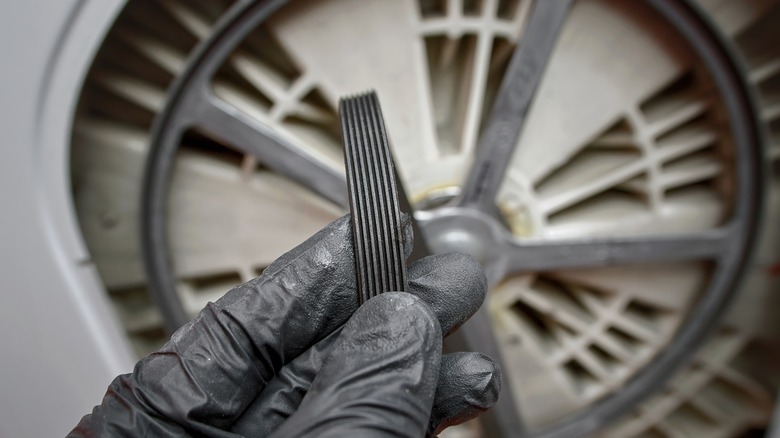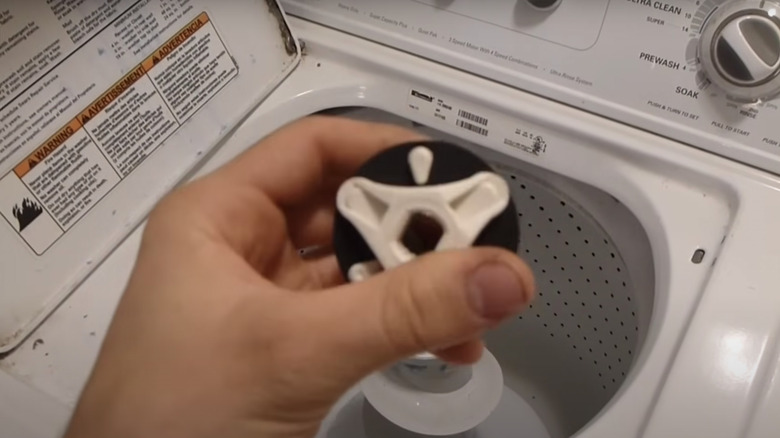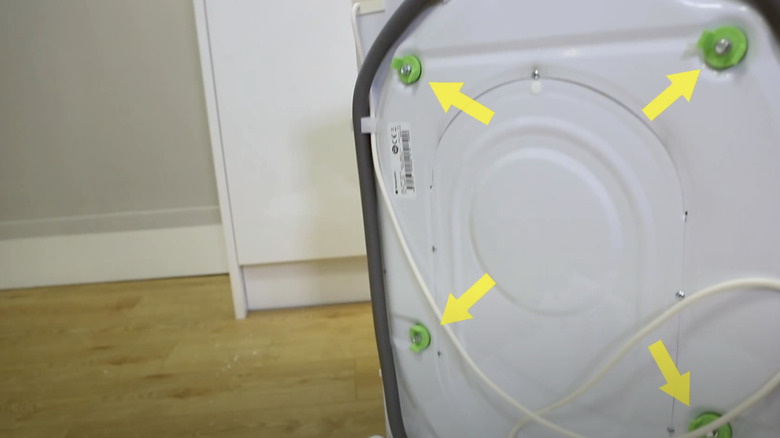Why Your Washing Machine Is Shaking Like Crazy (And What To Do About It)
A washing machine that shakes excessively can be both incredibly annoying and inefficient. First, excessive vibrations and movement cause a disruptive and noisy home environment. You won't be able to do a load of laundry during a Zoom meeting because it sounds like a war zone in your house. Or your neighbors will bang on your ceiling because doing laundry at 6 a.m. is disrupting their Saturday sleep-in.
Plus, the constant shaking can lead to wear and tear, shortening the appliance's lifespan and requiring more frequent repairs. Washing machines that shake a lot are also more likely to go on tilt, which means stinky, sopping wet clothes. There are plenty of reasons that your washing machine is shaking like crazy. Luckily, most of them are fixable in a quick, DIY fashion. You don't need to call a plumber, and you don't need to spend hours learning how to repair the drum's suspension. Instead, with a few quick adjustments here and there, you'll be back to an extra quiet washing machine in no time.
You have loaded it wrong
One of the most common reasons your washing machine starts shaking like a rocket about to take off is because you've loaded it wrong. It's easy to want to power through your laundry as quickly as possible and stuff it as full as possible. Because of that, you might mix heavy towels with delicate underwear, fill it to the brim, and call it a day. However, this can lead the machine to go off balance or "on tilt" and begin to shake violently.
Luckily, there is an easy fix. To address this, you just need to carefully redistribute the laundry within the drum. Be sure to take the time to ensure it's balanced evenly with at least one "heavier" thing, like a towel on either side of the center, to balance things out. If you have to, take some of the laundry out to lighten the load so things have room to move around. This helps you avoid overloading your washing machine. Once you've done this, restart the appliance, and it should operate smoothly without all the shaking.
It might not be leveled properly
Your washing machine might be shaking like crazy because it is not leveled properly. Sometimes, the feet on the bottom can become warped. They might break due to old age, or you can have bent them when you moved the appliance for cleaning or to grab a rouge sock. You might have also simply placed your machine on uneven ground. Whatever the cause, it won't stop shaking until you fix the broken foot or level the ground it's standing on.
You can purchase legs for your washing machine at any major hardware store, like Lowe's or Home Depot, or online at places like Amazon. They typically come in sets of four, so it's a good idea to replace all of them at once to ensure they are all the same height and will deteriorate at the same pace. Installation is an easy DIY project. You should unplug the appliance for safety, then prop it up on a piece of sturdy wood to reach the underside. When adjusting the new legs, you can place a level on its top to ensure you have them all at the same height. However, if your issue is uneven ground, you will most likely need to hire a contractor to get it straight again. If that's not currently within your budget, you can use leveling shims for the time being.
It has worn-out suspension springs
If your washing machine is trying to shake itself out of your laundry room, worn-out suspension springs might be the culprit. They are responsible for supporting and stabilizing the drum while you're using it. These springs can wear down or become damaged due to how much we use these machines. When this happens, the drum loses its stability, causing the washing machine to shake. Fortunately, the solution to this problem is relatively straightforward, as you just have to replace the springs. However, before trying to replace them, it's a good idea to confirm the absorbers are the issue. To find them, remove the top or back panel of the appliance and look at the base and sides of its drum. See if there is any damage present, like cracks or rust. If so, they are likely the issue.
You can grab replacement springs at most hardware stores. If you are unsure about the correct kind, Google your appliance's specific type. To start the replacement process, disconnect the power supply to the washing machine. Next, carefully remove the old springs and replace them with the new ones. If they are not screwed in all the way, the appliance might still shake, so be careful. The new shock absorbers should then work in harmony with the suspension springs to keep the movement of your washing machine to a minimum.
It might have worn-out drum bearings
A washing machine drum bearing is the main support system for the appliance. It allows the drum to spin effortlessly while maintaining stability and alignment. The bearing essentially acts as a friction-reducing barrier between the fixed and moving parts of the drum. It is meant to prevent excessive wear, ensuring you can use the appliance for years to come. Unfortunately, through time and extensive use, these bearings can wear out. This leads to disruptions, like increased noise and difficulty in drum movement.
To confirm if worn drum bearings are the reason your machine is wobbling so much, you'll need to perform a simple check. Start by manually spinning the drum — if you feel any resistance, hear grinding noises, or notice unusual movement, it's a clear indicator that the drum bearings are worn and need replacement. Doing so as soon as possible will increase the life of the machine.
To fix things, you'll likely need to remove the drum, which might involve disassembling certain parts of the appliance. It's different for different models, especially top and front loaders. For best results, look up yours online for specific instructions. Once you have access to the drum, locate the worn-out bearings and carefully remove them with a wrench. Replace them with the new bearings, ensuring a secure fit. Reassemble the washing machine, plug it back in, and run a test cycle. If the drum spins smoothly without excess noise or wobbling, all is well.
An imbalanced agitator can be the culprit for a top loader
If your top-loading washing machine is shaking during its cycles, the cause could be an imbalanced pulsator. The agitator is the central mechanism that helps move the clothes around in the drum. However, if it's misaligned or damaged, it can cause imbalances in the load and disrupt the process. To stop the shaking, you might need to adjust it or replace it altogether.
Start by carefully removing it from the machine. Depending on the model of your washing machine, you may need to follow specific instructions from the manufacturer to disassemble it. In some cases, it's just a matter of unscrewing the part. Next, inspect the agitator for visible misalignment, damage, or foreign objects that might be causing the imbalance. While the agitator itself probably isn't broken (since it's a large piece of plastic,) the piece it's attached to might be. In the agitator's center is a metal insert that connects it to the clutch that spins it. If the splines on the metal insert or the drive shaft of the clutch are worn down, they will need to be replaced.
If adjustment doesn't resolve the issue, you may need to consider replacing the agitator. Purchase a replacement one compatible with your washing machine model. For the best results, Google the specifics to remove the old agitator and install the new one securely in the appliance you have at home.
There might be some loose bolts
When the machine is manufactured and transported, bolts are initially tightened securely to ensure stability. However, if these bolts loosen or aren't adequately fastened over time, they can't effectively secure the drum and other internal components during its high-speed rotations. One of the most frustrating causes of a shaking washing machine is a loose bolt. It's the most annoying because there are so many bolts involved in the appliance that it can be difficult to determine exactly where the loose one is.
To fix things up, grab an adjustable wrench and begin your search. You will need to move methodically, checking each cluster to ensure they are all tight. Look at the bolts on the rear panel, which hold the back cover in place. Check the top of the machine, as these secure the top panel to the main body, providing structural stability. Next, look at the drum bolts, which are inside the machine. Finally, have a look at the ones used to secure the motor to the frame and the suspension bolts. Give each a quick turn, but don't force them, as too much tightening might cause them to crack.
There is a damaged or loose drum spider
The drum spider is a critical structural component that connects the drum to the tub. It is typically at the back of the drum and has three arms, which are attached to the drum by bolts. The part helps maintain its stability during operation. If the drum spider becomes damaged or loose, it can cause erratic movements and imbalance during the spin cycle. If this is the cause of the shaking, you will need to replace the entire part to restore balance.
To diagnose a damaged drum spider, start by turning off the washing machine and disconnecting it from the power source. Gently spin the drum by hand; if you can tilt it in the machine, almost "bending" it, the drum spider and its bearings might be at fault. Carefully remove the washing machine's top or back panel to access the drum spider. Inspect it closely for cracks, breaks, or signs of wear. If you discover damage, it's essential to replace it promptly to stop the shaking.
The drive belt might be loose
The drive belt is key to turning a washing machine's central drum. Because of how much we use washing machines, this belt is prone to becoming loose and stretching. This damage causes it to shake like crazy, as the drum isn't held in place properly. To stop the shake, you will need to either tighten or replace the belt, depending on how bad things look.
The belt will normally be at the back of the appliance. Once you've unplugged the machine, turned off the water valve, and removed the back panel, take a look for any really obvious signs that something is wrong. This could be fraying, sagging, or even a rip. You can attempt to gently move the belt with your hand; if there is excessive slack or the belt easily shifts, this means it is too loose. To tighten it up, you will need to access the drive motor and adjust the belt tension. The best way to do this is different for different machines, so make sure to Google how to do so with your particular model. However, most likely you will just need to loosen the mounting nut on the motor, push the motor to increase tension in the belt, and while applying that pressure, retighten the mounting nut.
However, if the drive belt is visibly damaged or severely loose, you will need to replace it entirely. A new belt should stop the shaking by holding things in place once again.
The motor coupler might be worn
If your washing machine is experiencing issues with spinning or agitating, a worn-out motor coupler might be the culprit. The motor coupling serves as a vital link between the motor and the transmission. It enables the drum's rotation during wash and spin cycles. Over time, due to frequent use and stress, the coupler can wear out or become damaged. This leads to a loss of power transmission and causes the washing machine to underperform (and shake excessively).
To check if this is the cause, start by finding the appliance's motor. It is usually located beneath the machine or accessed by removing panels. To replace the motor coupler, you'll need to purchase a compatible replacement for your model. While this is possible for more savvy DIYers, those newer to the task or less comfortable working with wires should hire a handyman. This is because the repair typically involves disconnecting the motor, detaching the old coupler, attaching the new one, and reattaching the motor. While simple enough, most will want the assurance of knowing they are not going to electrocute themselves.
The shipping bolts might still be on
Retailers typically use shipping bolts to secure the washing machine's drum during transportation and installation. These bolts make sure everything remains stable and undamaged. However, they must be removed after installation to allow the drum to move freely. If you accidentally leave these bolts in place, they can restrict the drum's movement. This leads to significant vibrations and a very noisy appliance. To address this issue and restore your washing machine's proper functioning, the solution is simple: remove any remaining shipping bolts.
If you just bought your appliance, this is the first thing you should check, just in case. Shipping bolts are typically found in the back of the appliance. If you find any bolts protruding, especially in sets of four or more, it's likely that the shipping bolts were not removed during installation. It's easy to pop them off — just use a wrench and you should be done in five minutes.
